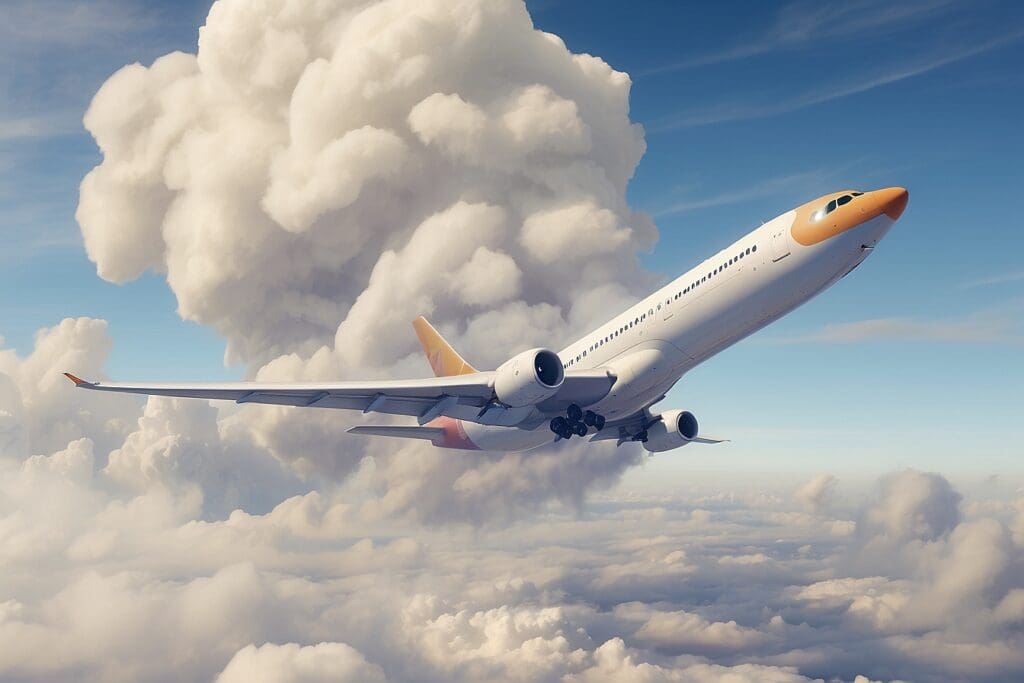You’ve probably thought about how you are contributing to 1. In fact, airplane trips are responsible for 11% of the United States’ transportation emissions.2
Airplanes and Greenhouse Gas Emissions

At takeoff airplanes weigh hundreds of thousands of pounds comprised of the machinery itself along with crew, passengers, luggage, food and beverages.3 It takes a lot of oomph to get so much weight off the ground and across the country or globe. To make the trip possible, planes are usually equipped with two jet engines. In the early decades of flight, airplanes and cars used the same kind of gasoline. However, as airplanes became larger, they needed a different kind of gasoline. WikiAnswers explains:
Most gas in the early 1900s had octane ratings of 87 or less. While that was enough for a car to work, airplane engines needed a higher octane grade. Fuel is rated according to its level of octane. The octane rating of gasoline tells how much the fuel can be compressed by the cylinders before it ignites. The higher the octane, the more compression it can handle before igniting. Higher octane levels allow engines to burn fuel more efficiently, rather than “knock,” which indicates engine strain and potential damage. Merely increasing the octane wasn’t enough for efficient flight, though. High-octane gas has a low flashpoint-the temperature at which it can catch fire by an open flame. Gasoline’s flashpoint is around -1 degrees Celsius [°C] (30 degrees Fahrenheit [°F]). Aviators wanted a fuel that would be safer. At first, aviators used a mixture of kerosene and gasoline. It was called Jet Propellant 1 (JP-1), but a drawback was the way it smoked as it burned. Aircraft then went to using Jet-A commercial jet fuel. It is kerosene-based and has a flashpoint of 49 °C (100 °F). It’s a high-quality fuel that includes an anti-freeze to prevent ice buildup inside fuel tanks.4
Burning fossil fuels like kerosene primarily produces carbon dioxide (CO2). Other major emissions are nitric oxide (NO) and nitrogen oxide (NO2), which together are called NOx, sulfur oxides (SO2), and but you may know less about NOx, which contributes to the formation of ozone. Aircraft also emit water vapor at high altitudes, creating condensation trails or “contrails,” which are the cloud-like lines you see coming out of aircraft. The effect of contrails is not well documented, but many scientists believe that airplane contrails are associated with increased cirrus cloud cover, which might also warm the Earth’s surface.5
To understand just how much airplane travel contributes to . “For many people in New York City, who don’t drive much and live in apartments, this is probably going to be by far the largest part of their carbon footprint,” says Anja Kollmuss, a Zurich-based environmental consultant.7
The Future of Aircraft Emissions
The worst thing about airplane emissions is that they are expected to increase more than 3 times by the middle of the century.9 In order to help curb some of these emissions, there are a number of proposals including:
- – Developing policies and guidelines for low greenhouse gas emissions travel;
- – Encouraging airlines to purchase renewable energy credits;
- – Taxing travel;
- – Encouraging passengers to purchase carbon offsets ;
- – Enhancing and expanding video conferencing to reduce business travel;
- – Developing alternative fuels for airplanes;
- – Decreasing air travel in general for individuals. 10
In 2008 the European Union (EU) decided to include airplane emissions in its emissions control plan (air travel is not regulated under the scheme. Unfortunately, opposition to the plan was so strong that the law is currently frozen for inter-continental flights, and the plan currently only addresses airlines operating solely in the EU.11 There is a new petition to the U.S. State Department demanding reduction of air pollution by the airline industry in the U.S. to follow that of the EU which you can sign here!
The idea of taxing air travel ultimately gets to the notion stated by the European climate action Commissioner: “[w]e believe that those of us who can afford to pay for an air ticket can also afford to pay for the pollution from their travel.”12 The Edmonton Journal, for example, recently ran an article discussing how frequent flyers from upper income households produce a large volume of greenhouse gas emissions; their flights alone pump out three times the total emissions coming from middle class households, including heat, power, and car travel.13 This means that even if you are driving a prius and making environmentally preferable choices, your neighbor’s monthly business trips might cancel out all of your hard work.
Airlines are worried that taxing air travel also might make airplane trips prohibitively expensive for lower-income families. In order to avoid raising trip costs, airlines are scrambling to cut CO2 emissions through new technology, alternative fuels, and increased efficiency. As one airline spokesperson put it, “With fuel costs doubling in the last year, airlines already have an incentive to work towards greater efficiency… There has been a 70 percent improvement in fuel efficiency in the last four decades. Aviation is a benchmark of environmental responsibility for others to follow.”14
Recently there was more bad news about airplane emissions. Increasing emissions is leading to a warming climate which is now believed to result in more extreme turbulence, the kind that could cause life threatening injuries or even take out the engine on a plane. This extreme turbulence is projected to hit transatlantic flights by 2050, leading to more detours with longer flight paths to avoid these zones, and hence even more emissions and pollution from air travel.15 It’s the classic catch 22, but in this case many believe it is at least somewhat avoidable as we have the information and ability now to curtail our emissions and .
If you are concerned about the emissions associated with your personal air travel, one way to help is by calculating your trip emissions (travelnav.com/flight-emissions), and offsetting them.16,17 You can also try to take a train, other public transportation, or ride share, especially if you are contemplating a flight that is less than an hour long.





